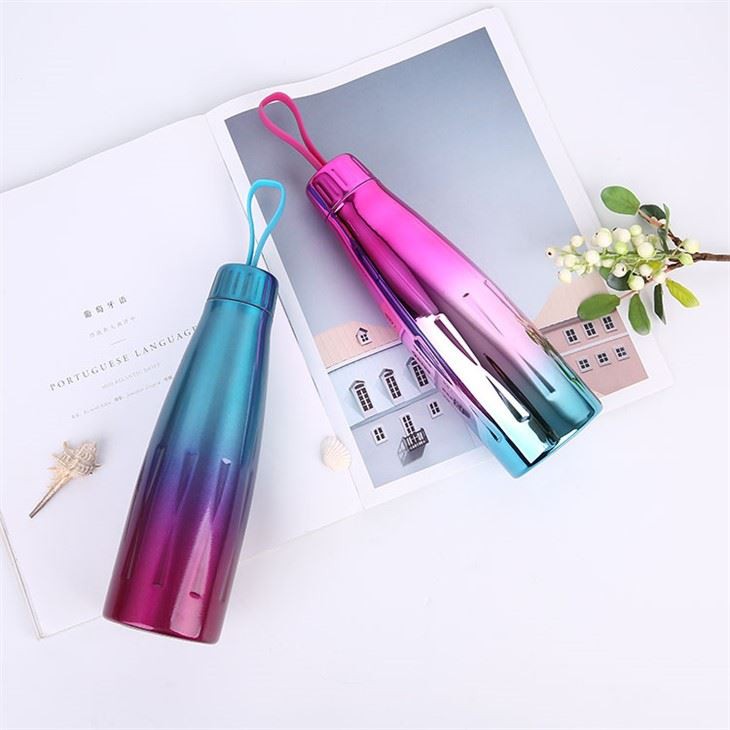How to prevent wine from oxidizing in a metal sport wine bottle?
Jul 10, 2025
Wine is a delicate beverage that can easily be affected by oxidation, which can significantly alter its flavor, aroma, and overall quality. As a supplier of Metal Sport Wine Bottles, I understand the importance of preserving the integrity of wine during transport and storage. In this blog post, I will share some effective strategies on how to prevent wine from oxidizing in a metal sport wine bottle.
Understanding Wine Oxidation
Before delving into prevention methods, it's essential to understand what causes wine oxidation. Oxidation occurs when wine comes into contact with oxygen. When oxygen interacts with the compounds in wine, such as tannins and pigments, it can lead to chemical reactions that change the wine's characteristics. Over time, oxidized wine may develop a brownish color, lose its fruitiness, and take on a flat, sherry - like flavor.
Choose the Right Metal Sport Wine Bottle
The first step in preventing wine oxidation is selecting the appropriate metal sport wine bottle. Our Double Wall Insulated Sports Bottle is an excellent choice. The double - wall construction provides better insulation, which helps maintain a stable temperature inside the bottle. Temperature fluctuations can accelerate the oxidation process, so keeping the wine at a consistent temperature is crucial.
Stainless steel is the ideal material for wine storage as it is non - reactive with wine. Unlike some other metals, stainless steel does not leach any unwanted substances into the wine, and it forms a barrier that limits the amount of oxygen that can penetrate the bottle. Our Leak Proof Sports Water Bottle ensures that there are no air leaks, further reducing the risk of oxygen ingress.
Fill the Bottle Properly
When filling the metal sport wine bottle, it's important to minimize the amount of air space inside. Air contains oxygen, so the more air there is in the bottle, the greater the potential for oxidation. Fill the bottle as close to the brim as possible without causing spillage. This reduces the surface area of the wine exposed to oxygen and limits the amount of oxygen available for reaction.
If you can't fill the bottle completely, you can use an inert gas, such as argon or nitrogen, to displace the air. These gases are heavier than oxygen and will settle on top of the wine, creating a protective layer that prevents oxygen from reaching the wine. Some wine - related products are available that dispense these inert gases into the bottle.
Seal the Bottle Tightly
A tight seal is essential for preventing oxygen from entering the bottle. Our Double Wall Insulated Sport Water Bottle is designed with a high - quality sealing mechanism. Make sure the cap is screwed on tightly after filling the bottle. Check the seal regularly, especially if you are transporting the bottle over long distances or subjecting it to vibrations. A loose seal can allow air to seep in, leading to oxidation.
Store the Bottle Correctly
Proper storage is another key factor in preventing wine oxidation. Keep the metal sport wine bottle in a cool, dark place. Heat can speed up the oxidation process, so avoid storing the bottle in direct sunlight or in a hot environment. A cellar or a cool pantry is an ideal storage location.
If you are using the bottle for outdoor activities, try to keep it shaded and away from heat sources. For example, if you are on a picnic, place the bottle in a cooler with ice packs to maintain a low temperature.
Limit Handling and Agitation
Excessive handling and agitation of the wine bottle can increase the rate of oxidation. When you shake or move the bottle vigorously, you expose more of the wine's surface area to the oxygen inside the bottle. This promotes the mixing of oxygen with the wine and accelerates the oxidation reactions.
When transporting the bottle, handle it gently. If possible, place it in a padded container to reduce the impact of bumps and vibrations.
Use Oxygen Absorbers
Oxygen absorbers are small packets that contain substances that react with oxygen to remove it from the air. You can place an oxygen absorber inside the metal sport wine bottle before sealing it. These absorbers can help reduce the oxygen levels inside the bottle and slow down the oxidation process. However, make sure the oxygen absorber is food - safe and designed for use with wine.
Monitor the Wine Regularly
Even with all the preventive measures in place, it's a good idea to monitor the wine regularly. Check for any signs of oxidation, such as changes in color, aroma, or taste. If you notice any off - flavors or a loss of freshness, it may be a sign that the wine is starting to oxidize. In such cases, it's best to consume the wine sooner rather than later.


Conclusion
Preventing wine from oxidizing in a metal sport wine bottle requires a combination of proper bottle selection, filling techniques, sealing, storage, and handling. By following these strategies, you can ensure that your wine stays fresh and retains its original flavor and aroma for a longer period.
As a supplier of high - quality Metal Sport Wine Bottles, we are committed to providing products that meet the needs of wine enthusiasts. Our bottles are designed with features that help protect the wine from oxidation and ensure a great drinking experience.
If you are interested in purchasing our Metal Sport Wine Bottles for your personal use or for your business, we invite you to contact us for more information and to discuss your specific requirements. We look forward to the opportunity to serve you and help you preserve the quality of your wine.
References
- Jackson, R. S. (2008). Wine Science: Principles, Practices, Perceptions. Academic Press.
- Robinson, J., Harding, J., & Vouillamoz, J. (2012). Wine Grapes: A Complete Guide to 1,368 Vine Varieties, Including Their Origins and Flavours. Allen & Unwin.
